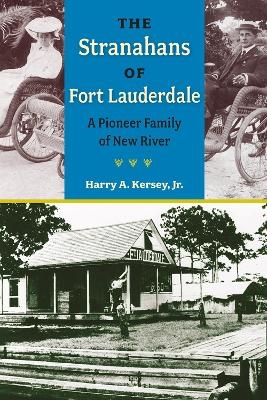
The Stranahans of Fort Lauderdale
A Pioneer Family of New River
Seiten
2022
University Press of Florida (Verlag)
978-0-8130-6891-6 (ISBN)
University Press of Florida (Verlag)
978-0-8130-6891-6 (ISBN)
The story of two individuals who shaped the development of one of Florida’s major urban centers. Frank and Ivy Stranahan are today recognised as a founding family of Fort Lauderdale and their riverfront home has been restored and designated a National Historic Landmark.
Two individuals who shaped the development of one of Florida's
major urban centers
When
they married in 1900, Frank and Ivy Stranahan began a life together on the
Florida frontier that would shape and define the development of one of the
state's most sophisticated urban centers. Pioneering spirit and economic
enterprise linked them to Seminole Indians, venture capitalists, and colorful
entrepreneurs along the New River settlement; today they're recognized as a
founding family of Fort Lauderdale and their riverfront home has been restored
and designated a National Historic Landmark.
Frank Stranahan came south from Ohio in 1893 to run an overnight camp on the
stagecoach line carrying passengers from Lake Worth to the Miami area. He soon
opened a trading post that thrived on commerce in pelts, plumes, and hides with
Seminole Indians, who in turn purchased goods and groceries to take back to
their camps in the Everglades. Stranahan's business interests expanded to
include real estate and banking. An honest businessman, he became a respected
political and civic leader, instrumental in the birth of Fort Lauderdale in
1911. When the Florida land boom collapsed and his bank closed, Stranahan's
mental and physical health failed, and he committed suicide in 1929.
Ivy
Cromartie, a native Floridian, was 18 when she arrived at the settlement as its
first schoolteacher and met her future husband. Energetic and articulate, she
focused her activities outside the home. Besides teaching, she was active in a
variety of reform movements ranging from Audubon Society efforts to save the
plume birds to temperance and women's suffrage, working mainly through the
Florida Federation of Women's Clubs. She is best remembered for her role as an
advocate for Indigenous American rights—especially education and child
welfare—primarily with the Friends of the Seminoles, an organization she
established in the 1930s. Before her death in 1971 she spoke frequently about
her full life to reporters and historians and was interviewed extensively by
Kersey.
Two individuals who shaped the development of one of Florida's
major urban centers
When
they married in 1900, Frank and Ivy Stranahan began a life together on the
Florida frontier that would shape and define the development of one of the
state's most sophisticated urban centers. Pioneering spirit and economic
enterprise linked them to Seminole Indians, venture capitalists, and colorful
entrepreneurs along the New River settlement; today they're recognized as a
founding family of Fort Lauderdale and their riverfront home has been restored
and designated a National Historic Landmark.
Frank Stranahan came south from Ohio in 1893 to run an overnight camp on the
stagecoach line carrying passengers from Lake Worth to the Miami area. He soon
opened a trading post that thrived on commerce in pelts, plumes, and hides with
Seminole Indians, who in turn purchased goods and groceries to take back to
their camps in the Everglades. Stranahan's business interests expanded to
include real estate and banking. An honest businessman, he became a respected
political and civic leader, instrumental in the birth of Fort Lauderdale in
1911. When the Florida land boom collapsed and his bank closed, Stranahan's
mental and physical health failed, and he committed suicide in 1929.
Ivy
Cromartie, a native Floridian, was 18 when she arrived at the settlement as its
first schoolteacher and met her future husband. Energetic and articulate, she
focused her activities outside the home. Besides teaching, she was active in a
variety of reform movements ranging from Audubon Society efforts to save the
plume birds to temperance and women's suffrage, working mainly through the
Florida Federation of Women's Clubs. She is best remembered for her role as an
advocate for Indigenous American rights—especially education and child
welfare—primarily with the Friends of the Seminoles, an organization she
established in the 1930s. Before her death in 1971 she spoke frequently about
her full life to reporters and historians and was interviewed extensively by
Kersey.
Harry A. Kersey, Jr. (1935-2021) was professor emeritus of history at Florida Atlantic University. He is the author of several books, including The Florida Seminoles and the New Deal, 1933-1942 (UPF, 1989) and Pelts, Plumes, and Hides: White Traders among the Seminole Indians, 1870-1930 and the coauthor of Buffalo Tiger: A Life in the Everglades.
| Erscheinungsdatum | 08.06.2022 |
|---|---|
| Reihe/Serie | Florida History and Culture |
| Verlagsort | Florida |
| Sprache | englisch |
| Maße | 152 x 229 mm |
| Gewicht | 151 g |
| Themenwelt | Literatur ► Biografien / Erfahrungsberichte |
| Geisteswissenschaften ► Geschichte ► Allgemeine Geschichte | |
| Geisteswissenschaften ► Geschichte ► Regional- / Ländergeschichte | |
| ISBN-10 | 0-8130-6891-6 / 0813068916 |
| ISBN-13 | 978-0-8130-6891-6 / 9780813068916 |
| Zustand | Neuware |
| Haben Sie eine Frage zum Produkt? |
Mehr entdecken
aus dem Bereich
aus dem Bereich
eine Familiengeschichte der Menschheit
Buch | Hardcover (2023)
Klett-Cotta (Verlag)
CHF 68,60
Eine wahre Geschichte von Schiffbruch, Mord und Meuterei
Buch | Hardcover (2024)
C.Bertelsmann (Verlag)
CHF 34,95


